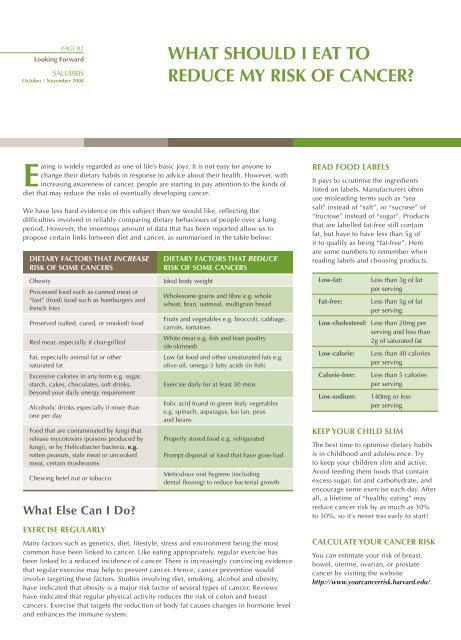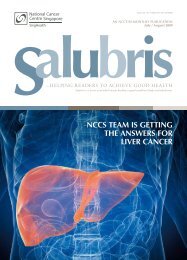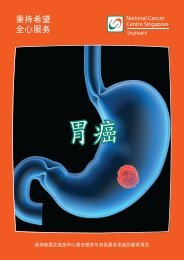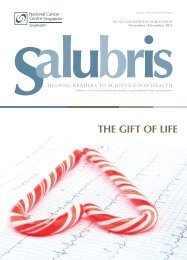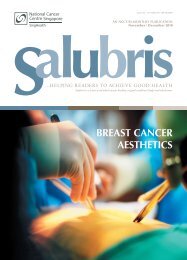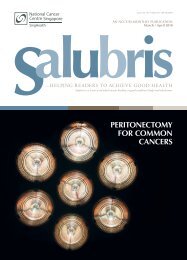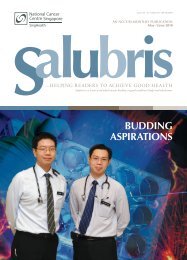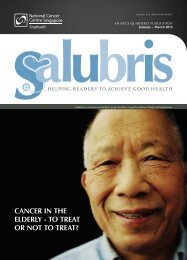Public Version - National Cancer Centre Singapore
Public Version - National Cancer Centre Singapore
Public Version - National Cancer Centre Singapore
You also want an ePaper? Increase the reach of your titles
YUMPU automatically turns print PDFs into web optimized ePapers that Google loves.
Page B2<br />
Looking Forward<br />
SALUBRIS<br />
October / November 2008<br />
What Should I Eat To<br />
Reduce My Risk of <strong>Cancer</strong>?<br />
Eating is widely regarded as one of life’s basic joys. It is not easy for anyone to<br />
change their dietary habits in response to advice about their health. However, with<br />
increasing awareness of cancer, people are starting to pay attention to the kinds of<br />
diet that may reduce the risks of eventually developing cancer.<br />
We have less hard evidence on this subject than we would like, reflecting the<br />
difficulties involved in reliably comparing dietary behaviours of people over a long<br />
period. However, the enormous amount of data that has been reported allow us to<br />
propose certain links between diet and cancer, as summarised in the table below:<br />
Dietary Factors that Increase<br />
Risk of Some <strong>Cancer</strong>s<br />
Obesity<br />
Processed food such as canned meat or<br />
“fast” (fried) food such as hamburgers and<br />
french fries<br />
Preserved (salted, cured, or smoked) food<br />
Red meat, especially if char-grilled<br />
Fat, especially animal fat or other<br />
saturated fat<br />
Excessive calories in any form e.g. sugar,<br />
starch, cakes, chocolates, soft drinks,<br />
beyond your daily energy requirement<br />
Alcoholic drinks especially if more than<br />
one per day<br />
Food that are contaminated by fungi that<br />
release mycotoxins (poisons produced by<br />
fungi), or by Helicobacter bacteria, e.g.<br />
rotten peanuts, stale meat or uncooked<br />
meat, certain mushrooms<br />
Chewing betel nut or tobacco<br />
What Else Can I Do?<br />
Exercise Regularly<br />
Dietary Factors that Reduce<br />
Risk of Some <strong>Cancer</strong>s<br />
Ideal body weight<br />
Wholesome grains and fibre e.g. whole<br />
wheat, bran, oatmeal, multigrain bread<br />
Fruits and vegetables e.g. broccoli, cabbage,<br />
carrots, tomatoes<br />
White meat e.g. fish and lean poultry<br />
(de-skinned)<br />
Low fat food and other unsaturated fats e.g.<br />
olive oil, omega-3 fatty acids (in fish)<br />
Exercise daily for at least 30 mins<br />
Folic acid found in green leafy vegetables<br />
e.g. spinach, asparagus, kai lan, peas<br />
and beans<br />
Properly stored food e.g. refrigerated<br />
Prompt disposal of food that have gone bad<br />
Meticulous oral hygiene (including<br />
dental flossing) to reduce bacterial growth<br />
Many factors such as genetics, diet, lifestyle, stress and environment being the most<br />
common have been linked to cancer. Like eating appropriately, regular exercise has<br />
been linked to a reduced incidence of cancer. There is increasingly convincing evidence<br />
that regular exercise may help to prevent cancer. Hence, cancer prevention would<br />
involve targeting these factors. Studies involving diet, smoking, alcohol and obesity,<br />
have indicated that obesity is a major risk factor of several types of cancer. Reviews<br />
have indicated that regular physical activity reduces the risk of colon and breast<br />
cancers. Exercise that targets the reduction of body fat causes changes in hormone level<br />
and enhances the immune system.<br />
Read Food Labels<br />
It pays to scrutinise the ingredients<br />
listed on labels. Manufacturers often<br />
use misleading terms such as “sea<br />
salt” instead of “salt”, or “sucrose” or<br />
“fructose” instead of “sugar”. Products<br />
that are labelled fat-free still contain<br />
fat, but have to have less than 5g of<br />
it to qualify as being “fat-free”. Here<br />
are some numbers to remember when<br />
reading labels and choosing products.<br />
Low-fat:<br />
Fat-free:<br />
Less than 3g of fat<br />
per serving<br />
Less than 5g of fat<br />
per serving<br />
Low-cholesterol: Less than 20mg per<br />
serving and less than<br />
2g of saturated fat<br />
Low-calorie:<br />
Calorie-free:<br />
Low-sodium:<br />
Less than 40 calories<br />
per serving<br />
Less than 5 calories<br />
per serving<br />
140mg or less<br />
per serving<br />
Keep Your Child Slim<br />
The best time to optimise dietary habits<br />
is in childhood and adolescence. Try<br />
to keep your children slim and active.<br />
Avoid feeding them foods that contain<br />
excess sugar, fat and carbohydrate, and<br />
encourage some exercise each day. After<br />
all, a lifetime of “healthy eating” may<br />
reduce cancer risk by as much as 30%<br />
to 50%, so it’s never too early to start!<br />
Calculate Your <strong>Cancer</strong> Risk<br />
You can estimate your risk of breast,<br />
bowel, uterine, ovarian, or prostate<br />
cancer by visiting the website<br />
http://www.yourcancerrisk.harvard.edu/.


